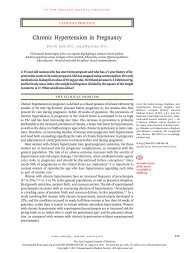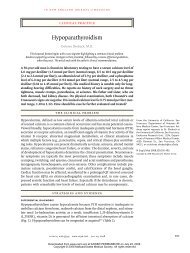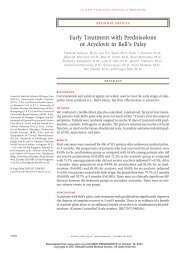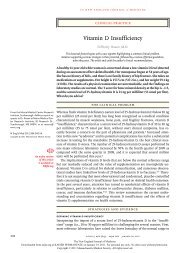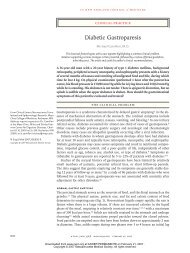Cervical radiculopathy - enotes - Q-Notes for Adult Medicine
Cervical radiculopathy - enotes - Q-Notes for Adult Medicine
Cervical radiculopathy - enotes - Q-Notes for Adult Medicine
Create successful ePaper yourself
Turn your PDF publications into a flip-book with our unique Google optimized e-Paper software.
clinical practicebral bodies) with the use of bone (either autograftor allograft) or synthetic materials (carbon fiberor titanium cages) and plate fixation. Posterior options,which are often used in cases of multileveldecompressions in which there is preserved cervicallordosis, include laminectomy (with or withoutinstrumented fusion) and laminoplasty (involvingdecompression and reconstruction of thelaminae).Data from prospective observational studiesindicate that two years after surgery <strong>for</strong> cervical<strong>radiculopathy</strong> without myelopathy, 75 percent ofpatients have substantial relief from radicular symptoms(pain, numbness, and weakness). 50,51 Correspondingresponse rates <strong>for</strong> relief of radicular armpain after surgery appear similar in patients treated<strong>for</strong> cervical myelopathy. 52Complications of surgery <strong>for</strong> cervical <strong>radiculopathy</strong>with or without myelopathy are uncommonbut can include iatrogenic injury to the spinal cord(occurring in less than 1 percent of cases), nerverootinjury (2 to 3 percent), recurrent nerve palsy(hoarseness, 2 percent after anterior cervical surgery),esophageal per<strong>for</strong>ation (less than 1 percent),and failure of instrumentation (breakage or looseningof a screw or plate or nonunion, less than5 percent <strong>for</strong> single-level surgery). 50-52ACSpinalnervesBsurgical vs. nonsurgical managementAs summarized in a recent Cochrane review, 53 thereare few good-quality studies comparing surgicaland nonsurgical treatments <strong>for</strong> cervical <strong>radiculopathy</strong>.In one randomized trial comparing surgicaland nonsurgical therapies among 81 patients with<strong>radiculopathy</strong> alone, the patients in the surgicalgroup had a significantly greater reduction in painat three months than the patients who were assignedto receive physiotherapy or who underwentimmobilization in a hard collar (reductions in visual-analoguescores <strong>for</strong> pain: 42 percent, 18 percent,and 2 percent, respectively). 54 However, atone year, there was no difference among the threetreatment groups in any of the outcomes measured,including pain, function, and mood.In patients with mild signs of cervical myelopathy(not meeting the above criteria <strong>for</strong> surgery),nonsurgical treatment is reasonable. This recommendationis supported by the results of a small,but otherwise well-designed, randomized trial in-Ligamentum flavumFigure 2. Surgical Approaches <strong>for</strong> the Treatment of <strong>Cervical</strong> Radiculopathy.Anterior cervical diskectomy (Panel A) can be per<strong>for</strong>med without spinal fusion,although more commonly a fusion (using a variety of biologic and syntheticmaterials) is per<strong>for</strong>med to prevent disk collapse and kyphosis. Asillustrated in the figure, this is commonly accompanied by anterior fixationof a plate to facilitate early return to normal activity. Anterior <strong>for</strong>aminotomywithout fusion is a possible alternative, but there is less clinical experiencewith this option. In cervical arthroplasty (Panel B), an artificial disk made ofvarious synthetic materials is inserted into the evacuated disk space after anteriorcervical diskectomy has been per<strong>for</strong>med. This procedure (which is notapproved by the Food and Drug Administration) is used outside the UnitedStates as an alternative to fusion in an ef<strong>for</strong>t to preserve motion and to minimizeadjacent segment degeneration. Small prospective case series showresults approximately equivalent to those with fusion at one-year follow-up,although randomized trials are lacking to show that arthroplasty results inless adjacent segment degeneration than does fusion. 49 Posterior lamino<strong>for</strong>aminotomy(Panel C) consists of a posterior decompression of the exitingcervical nerve root by partial removal of the lamina and medial facet and partialremoval of the disk or osteophytic spurs. This procedure is indicated only<strong>for</strong> a condition that is laterally placed (not <strong>for</strong> central stenosis).n engl j med 353;4 www.nejm.org july 28, 2005397Downloaded from www.nejm.org at KAISER PERMANENTE on July 28, 2005 .Copyright © 2005 Massachusetts Medical Society. All rights reserved.







